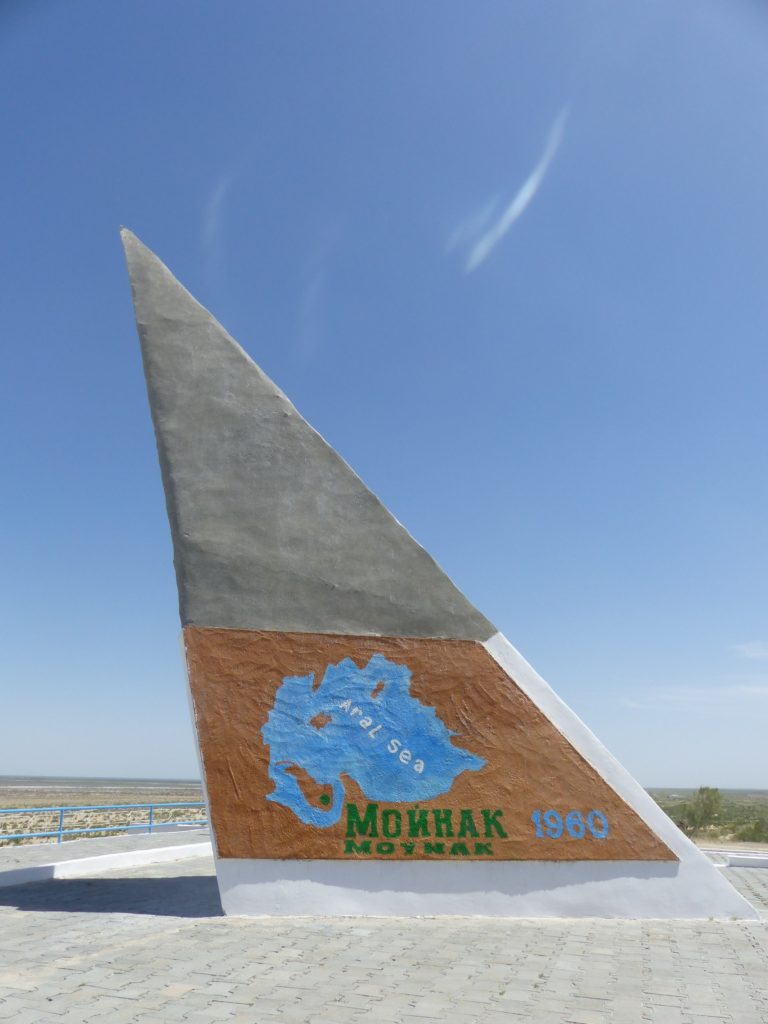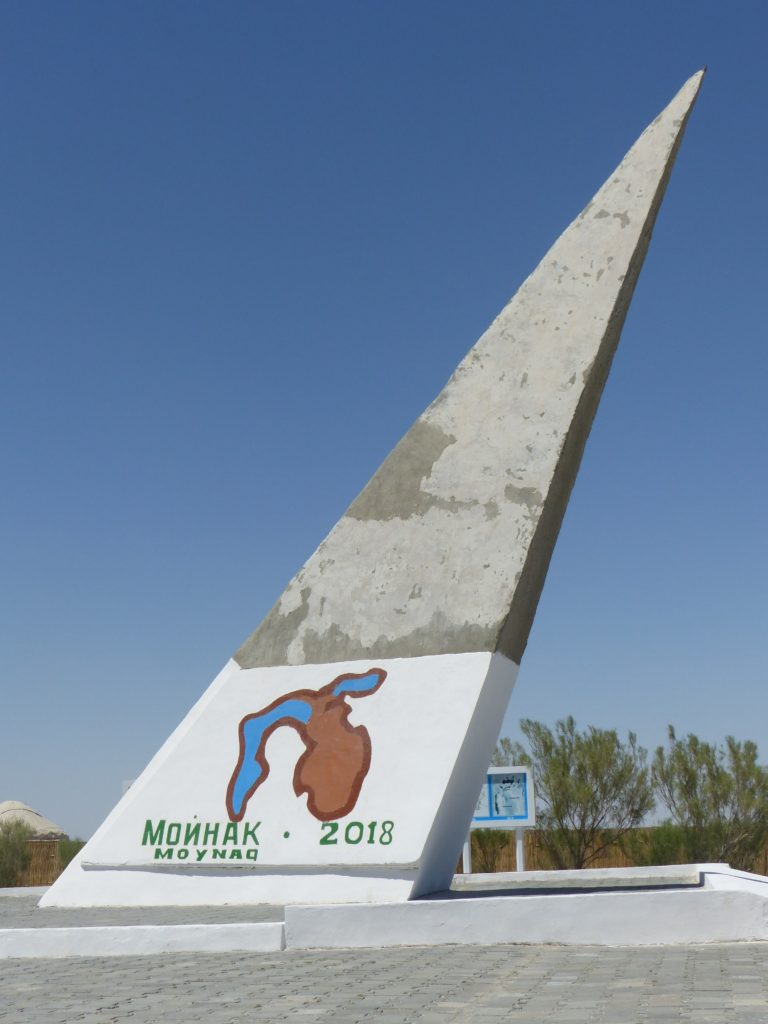Uzbekistan has another side, a more remote and desolate one. And it’s just a bit off the beaten path that runs from one Silk Road settlement to the next.
There are some old fortresses – 2000 years old, in fact – in the barren emptiness of ancient Khorezm, a now-historical kingdom that’s not far from Khiva. Some of the forts are not much more than crumbled mud-brick foundations but one of them, Ayaz-Qala, looks like an enormous sand castle in the desert.


It’s quiet in this part of Uzbekistan, heading far west.
Khorezm feels pretty remote. But it’s not nearly as remote as Nukus: a Soviet-built town of wide streets and decrepit apartment blocks which at first glance looks like a place where hopes and dreams go to die. That impression remained with me, even after a second and then a third glance. Being in Nukus feels a bit like being at the ends of the earth.
I arrived there with two other travellers after a long day in a share-taxi through the desert. It was a sunny day but also bleak, our rattling old car surrounded by yellow dirt and scrubby bushes, in a flatness that stretched on forever. We hadn’t gotten far before a rock hit one of the wheels and blew the tire, but the driver changed it quickly.

To make matters worse Cynthia wasn’t feeling well – she thought it was due to the taxi driver’s habit of erratic swerving all over the road and his fondness for sudden sharp turns but later it turned out to be her lunch.
In Nukus you aren’t spoiled for choice when it comes to accommodation. We checked into Hotel Nukus, a hotel which appears to exist in a sort of flux-state somewhere in between still being built and being demolished.
The manager led us to our damp basement room down a long, dark and musty low-ceilinged corridor littered with mattresses, smelling of mildew. And oddly enough, although we had a hot shower there was no sink in the bathroom, so we just brushed our teeth over the drain in the floor.

The generally depressing air of the place combined with the hard narrow beds primly lined up against the walls convinced us that it had once been a Soviet-style sanatorium, maybe in the 1930s.
Cynthia stayed in her cot at the sanatorium and apparently had the best evening of the three of us. Davide and I went out in search of food. It was getting late and we didn’t find much (but this was not Nukus’s fault, as it turns out. There are options but we were tired and didn’t ask before looking).
We ended up eating shashlik flavoured chips and sharing a carton of juice at the cafeteria across the vast and completely empty parking lot in front of our hotel (sharing a carton of juice isn’t an activity restricted to Nukus either by the way, people do that of an evening around here a lot in general. It just felt worse that night, in Nukus).

But we had come to Nukus for a reason, and it wasn’t because any of us thought we were coming down with tuberculosis and that a stay at the sanatorium was just the ticket.
We wanted to day-trip to Moynaq, a town around 200 kilometers away from Nukus and even more desolate, if possible (it actually is possible).
It’s not Moynaq’s fault that it has become a desolate ghost town. It was once a busy fishing village, perched right on the edge of the Aral Sea. And the Aral Sea once actually existed – thrived even – but most of it doesn’t exist anymore and that’s the problem.
Formerly a major port, Moynaq is now around 200 km from the seashore. Back in the 1950s the Aral Sea’s surface area was about 70 000 square feet. It was big and beautiful and it was full of fish – but then the USSR decided it was time to boost cotton production in the region. Growing cotton in the desert requires a lot of water and the irrigation channels took over the water supply from both the rivers that formerly fed the Aral Sea. As the plants grew, the sea shrank: the shoreline dropped away from Moynaq and the fishing industry literally dried up with the water.
Today the citizens of Moynaq are leaving in droves and the climate has changed. Since the seabed is now exposed to the air, salt and sand storms occur regularly and the dust travels on the wind for hundreds of kilometers.
There’s a fish leaping optimistically out of a rippling wave on the sign at the edge of town – now it’s just a sad reminder of the village’s prosperous past.

Now, a group of fishing vessels lie rusting on the sand at the edge of town.

The sun glared down on us as we poked around the hulking wrecks. It was like any other day at the seashore – shells underfoot, seagulls flying overhead – except there was no sea.


We’d arrived in time for a children’s day at the ship cemetery and kids were climbing all over the rusty relics but by the time we came back up to the memorial on the bluff that used to be the shore, the party was over and the families were gone.

The memorial shows an outline on one side of the Aral Sea as it was in 1960 and on the other side, the outline as it is today.


We sat in an empty cafe up above the ships and drank some beer; it was interesting day and a strange one, too.
And there’s yet another reason to visit Nukus: the Savitsky museum. During the Soviet era an artist named Igor Savitsky collected countless works of art which otherwise would have been destroyed for not conforming to the ideals of the time. He brought it here and kept it safe – nobody came looking in Nukus, and the collection has been here in this unlikely backwater ever since.
The next day the sanatorium released us and we parted ways. While Davide and Cynthia went back to Tashkent I stayed behind; homeless in this strange town. I felt like the last person on earth, or at least the only foreigner in Nukus.
I had a train to catch at 4 am so rather than pay for a half-night at the hotel I decided to kill time – maybe drown my sorrows in a carton of juce – and then go to the station as late as possible and just sleep on the station hall floor until departure.
But as I wandered past Hotel Nukus later that same evening, Eik the night manager ran out. It was too cold, he said (it was around 20 degrees) and he insisted that I come stay in our old room, for free. He offered me some food and set his own alarm to wake him before my train.
I set my alarm too and snatched a few hours of sleep.
‘You’re a beautiful woman’ said Eik as I staggered up the stairs from the basement at 3 am, still in the same clothes I’d worn the previous day and then slept in. ‘Are you married?’
But he also called me a cab and checked that I still had enough Uzbek currency left to pay for it, too.
I felt that I’d underestimated the sanatorium and maybe even Nukus – after all, I’d found a decent cafe to spend a few hours in and I certainly won’t forget Eik’s kindness any time soon.
I left Nukus in the dead of the night (ok – it’s dead all the time) and rode to the silent station. The train was waiting; I boarded it in the darkness and settled into my bunk for the long cross-border journey to Kazakhstan.
Read More
For more of my adventures (and misadventures) in Uzbekistan, check out the rest of my stories from the road.




This Post Has 2 Comments
This sounds like the beginning of a blossoming romance between you and Eik; I am happy for you, Sarah.